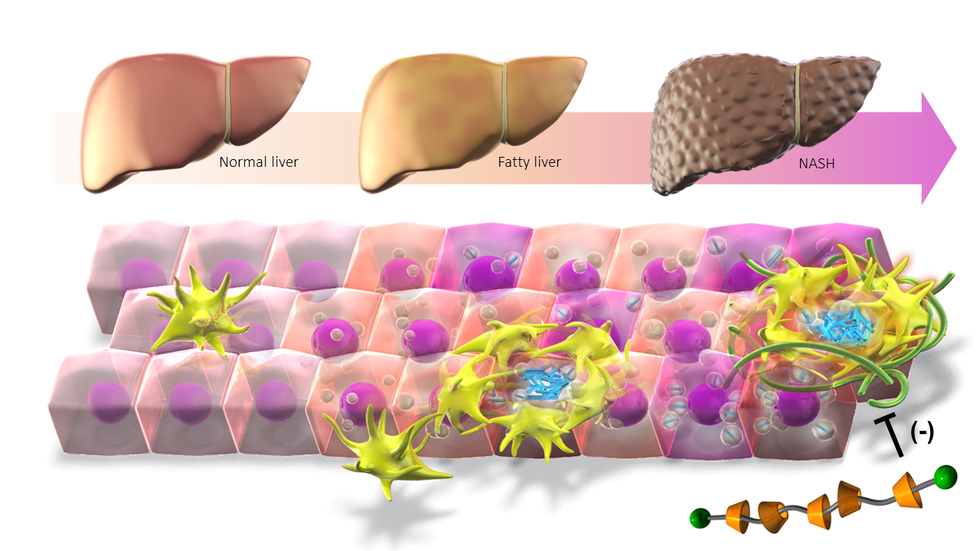
Medicine, Dentistry, and Pharmacy
September 21, 2023
Treating NASH disease by removing cholesterol from macrophages using a unique supramolecule
A research group from the Graduate School of Medicine and Research Institute of Environmental Medicine at Nagoya University reported that cholesterol accumulation in macrophages promotes liver fibrosis in the development of non-alcoholic steatohepatitis (NASH). Using a unique supramolecule, they removed cholesterol in a mouse model, stopping the development of the disease. As cholesterol crystals are also found in human patients, this suggests a potential treatment for the disease. Their findings were published in the Journal of Experimental Medicine.
As the number of patients with obesity increases, so do cases of fatty liver. Fatty liver risks progressing to NASH, a severe disease characterized by inflammation, fibrosis, and the increased death of the functional cells in the liver known as hepatocytes. Although it is known that cholesterol accumulation promotes NASH development, the precise mechanism is unknown.
Macrophages, the body’s immune cells, are also found around the dead hepatocytes, attracted to the inflamed liver tissue by signals released by damaged liver cells. Hepatocytes release cytokines, which amplify the inflammation, leading to tissue damage and fibrosis.
To further understand the mechanism, the group led by Nagoya University doctors Takayoshi Suganami (he, him) and Michiko Itoh (she, her) used a combination of techniques to identify cholesterol crystals in the lipids of the dead hepatocytes and the macrophages that engulf the cells.
To understand whether the cholesterol was involved in NASH, the researchers needed to find out if removing it improved the symptoms. To do this, they synthesized a unique supramolecule that combined the oligosaccharide β-cyclodextrin, which encapsulates free cholesterol, with a polymer to create β-cyclodextrin polyrotaxane (βCD-PRX). When they administered the supramolecule to mice, they found that it accumulated in the liver where it promoted excretion of cholesterol, which effectively stopped the progression of NASH.
“Cholesterol crystals are also observed in human NASH patients, which suggests that βCD-PRX could be a potential therapeutic strategy for human NASH,” Suganami said. “Recent advances in analytical techniques have led us to understand the characteristics of macrophages, which play crucial roles in the development of NASH. This study provides evidence that cholesterol overload triggers macrophage changes and promotes the development of NASH, which could be a novel therapeutic target.”
An advanced fatty liver disease called non-alcoholic steatohepatitis (NASH) is promoted by cholesterol
accumulation (blue) in macrophages (yellow). Using a unique supramolecule (bottom right),
researchers successfully removed cholesterol, stopping the progression of the disease.
Credit: T. Suganami & M. Itoh, Nagoya University
The study, "Lysosomal cholesterol overload in macrophages promotes liver fibrosis in a mouse model of NASH," was published in Journal of Experimental Medicine on September 19, 2023 at https://doi.org/10.1084/jem.20220681.
Authors:
Michiko Itoh, Atsushi Tamura, Sayaka Kanai, Miyako Tanaka, Yohei Kanamori1, Ibuki Shirakawa, Ayaka Ito, Yasuyoshi Oka, Isao Hidaka, Taro Takami, Yasushi Honda, Mitsuyo Maeda, Yasuyuki Saito, Yoji Murata, Takashi Matozaki, and Atsushi Nakajima
Media Contact:
Matthew Coslett
International Communications Office, Nagoya University
Email: icomm_research@t.mail.nagoya-u.ac.jp